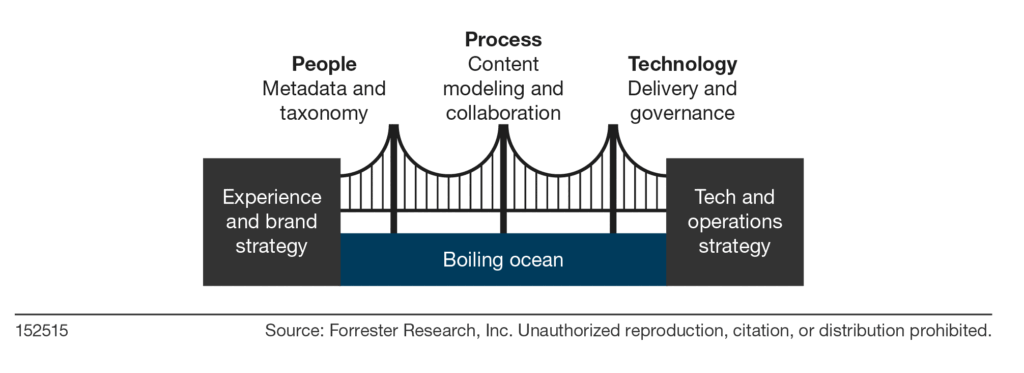A Content Strategy Tale — Good Bridges Make Good Neighbors
I recently published a report on content. This time, however, technology does not take center stage. It’s an ingredient for sure, but instead, a new operational paradigm steals the spotlight. The main reason: Change management — the intersection of org structure and culture — is the biggest barrier to success in digital experience initiatives (see the “Forrester Infographic: The State Of DX, 2019: Back To Basics“). This is especially true if you and your colleagues can’t work together (sort of like herding bunnies). Fancy, new software won’t help you tackle today’s digital experience challenges without also changing the way you work away from old, page-based publishing models.
In the world of digital content strategy, we have three archetypal stakeholders: content and creative teams, marketing campaign teams, and the technology and experience teams. And you can imagine the others that would come into play . . . the agency executive, governance and compliance manager, and many more. These cross-functional neighbors are classically dysfunctional, but we wanted to better understand these challenges and how to overcome them, so we spoke to 30 end users, agencies, and vendors.
We found two primary issues that are tantamount to clichés in 2019:
- Enterprises attempt to boil the ocean when it comes to content strategy. There are too many channels, journeys, content management systems, teams, etc. to fit within one all-encompassing strategy. An effective content strategy should allow for project- and team-level initiatives.
- Enterprises are reinventing the wheel all the time. Without centralized governance and reusable content, teams are continuously starting from scratch.
Even more importantly, when technology or marketing teams set out to solve “content strategy,” they meant very different things. So we can also say that we found fundamental misalignment between marketing and technology teams. ( . . . 1998 called and wants its stereotypical “barrier to success” back . . . )
Throughout our interviews, we did uncover a glimmer of best practices to prevent these common traps: Bridge the gap between customer understanding (i.e., the marketing side of the house) and technical execution (i.e., the corporate IT side of the house). As an age-old problem, connecting these two camps is easier said than done.
To help with this, we’ve proposed a content strategy “bridge” with three piers: people, process, and technology. Sounds like a classic fix, yet look below to see that this is also about metadata and modeling and governance, each built on digital foundations and linked by strategy that spans everyone’s needs. For more key tips and takeaways, check out our report, “A Practical Guide To Modern Content Strategy,” or set up an inquiry with me here. Also, a big shout-out to my colleagues who made this report possible: Allen Bonde, Emma Huff, and Ryan Skinner.
